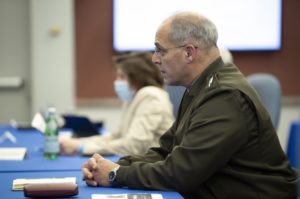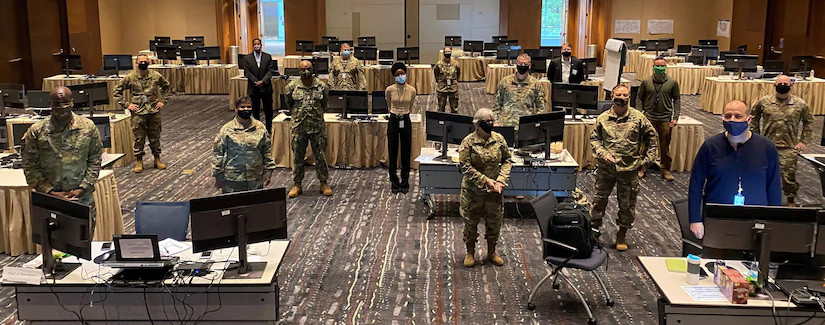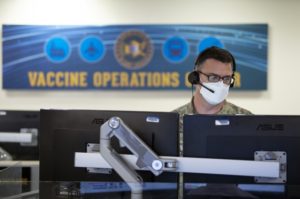DoD, CDC Tackle the Logistical Challenge of a Generation

Army Gen. Gustave F. Perna, chief operating officer of Operation Warp Speed, monitors a simulation exercise in Washington last month. Operation Warp Speed is an effort by several U.S. government components and public partnerships to facilitate the development, manufacturing and distribution of COVID-19 vaccines, therapeutics and diagnostics. DoD photo by EJ Hersom
ATLANTA — Operation Warp Speed already has achieved the nearly impossible by fostering the speedy development of COVID-19 vaccines. Now the real work begins.
From its launch in May 2020, OWS has maintained laser focus on developing and delivering a vaccine to 300 million Americans. With two vaccines for COVID-19 nearing U.S. Food and Drug Administration approval in the extraordinary space of 11 months, the DoD and national Centers for Disease Control and Prevention (CDC) have shifted their attention to the delivery half of the equation.
At the same time, the Department of Health and Human Services and its agencies, the National Institutes of Health and the Biomedical Advanced Research and Development Authority (BARDA), continue to work with the other four manufacturers who have received significant support through OWS to get their vaccines, which use different immunological platforms, across the finish line this spring.
Ten military officers with Operation Warp Speed are now embedded at the CDC to work out the brutal logistical challenge of distributing hundreds of millions of doses of vaccine to every city and rural outpost in America as quickly as possible. The task is further complicated by the vaccines’ varying transportation, minimum dose and storage requirements and the need to develop plans in conjunction with state, tribal, territorial and local public health programs that have widely divergent requirements, data and capabilities.
“The country’s existing public health infrastructure is well tested—we see evidence every fall when Americans receive the flu vaccine in large numbers. But these are not normal times,” Army Gen. Gustave Perna, MD, Operation Warp Speed’s chief operating officer, said. “Leveraging our military planning and logistics capability and combining that with proven methods will allow existing systems to scale quickly to get the vaccine to the American people.”

An Operation Warp Speed contingent in Atlanta is working with regional coordinators on the distribution efforts for the COVID-19 vaccine. They are based at national Centers for Disease Control and Prevention headquarters. DoD photo
Typically, a manufacturer would not produce large volumes of a vaccine until it received FDA approval. To speed administration of the vaccines, OWS underwrote more than $1 billion in large-scale manufacturing costs for six vaccine developers—Johnson & Johnson (Janssen), Moderna, AstraZeneca/Oxford University, Novavax, Pfizer, and Sanofi/GlaxoSmithKline—in exchange for guaranteed delivery of 100 million to 300 million doses if the vaccines receive FDA approval. Additional funds secured expanded manufacturing capacity for vaccines and adjunctive materials for their production and administration at several other companies.
As a result, the manufacturers had the confidence to start producing their vaccines at industrial scale before clinical trials demonstrating efficacy and safety concluded. By mid-December, Perna said 6.4 million doses of the Pfizer vaccine will be ready for distribution, pending FDA approval. By the end of the year, he anticipated that more than 40 million doses of the Pfizer and Moderna vaccines will be available.
“Timing for the first dose is the beginning, but we are going to be in continual distribution as production comes off the line daily or weekly—and it must be distributed,” said Deacon Maddox, OWS chief of plans, operations and analytics.
Epic Proportions

Traveling Warp Speed Toward COVID-19 Prevention, Treatment
Army Col. Aron Meadow works inside Operation Warp Speed headquarters in Washington last month. Operation Warp Speed is an effort by several U.S. government components and public partnerships to facilitate the development, manufacturing and distribution of COVID-19 vaccines, therapeutics and diagnostics. DoD photo by EJ Herson
To figure out how to do that, the liaisons from the Army, Navy and Air Force are partnered with a regional coordinator from the CDC to handle distribution to specific areas. Together, they are coordinating with regional officials to establish how best to package, ship and prioritize receipt of the vaccines to accomplish an immunization campaign of epic proportions.
“The CDC brings a lot to the table. They get vaccines out every year, from children’s immunizations to the flu vaccine,” OWS Director for Supply, Production and Distribution Paul Ostrowski said.
The DoD, on the other hand, has deep experience minimizing damage from missteps and unexpected events. “We still have several unknowns, but that is what the military is best at—planning for every contingency, and that is what we are helping states with now,” Maddox noted. “Every state is different—no two information systems are the same.”
The teams use the Tiberius platform to collect, analyze and visualize data from states and localities, the U.S. census and CDC. The system also will help them determine how many doses each jurisdiction receives and when based on the final recommendations on vaccination prioritization made by the CDC Advisory Committee on Immunization Practices. Tiberius also provides decision-support tools to facilitate development of distribution plans that pick up once OWS delivers the vaccine shipments to the states, tribes, territories and major cities. It simplifies coordination with McKesson, which will handle delivery to administration sites for most of the vaccines.
As importantly, working with a single platform improves visibility and tracking of the vaccine and ancillary items like syringes, to ensure the vaccines arrive where they are needed most with all the equipment necessary to administer and store them.
“We’re working on this constantly. We work rehearsals of different scenarios to make sure we’re capturing all the nuances of the delivery,” Perna said. “But each and every week we get stronger. Each week we’re one week closer to distributing the vaccine, we’re one week closer to refining to the exactness that we need to have to do this. And I’m very confident in that process.”
The teams are also working with local partners to develop plans to distribute the vaccine as broadly as possible. “We have to go beyond brick and mortar,” Ostrowski explained. “We have to get this to the long-term care facilities, to meat-packing plants. We have to go mobile to be able to cover the entire country and not depend on people to come to us.”
Ultimately, the plans must enable local providers to keep track of who received which vaccine and when. Five of the six vaccines supported by OWS require two shots, three or four weeks apart. While the Pfizer and Moderna vaccine work in remarkably similar ways, they are not interchangeable. The other four use two different platforms to prompt an immune response.
Immunologists for the constantly confounding COVID-19 situation have a favorite saying, “Vaccines don’t save lives. Vaccinating people (twice) saves lives.”
